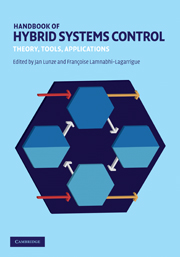Book contents
- Frontmatter
- Contents
- List of contributors
- Preface
- Notation
- Part I Theory
- Part II Tools
- 8 Overview of tools development and open problems
- 9 Verification tools for linear hybrid automata
- 10 Tools for modeling, simulation, control, and verification of piecewise affine systems
- 11 Modeling, simulation, and optimization environments
- 12 Interchange formats and tool integration
- Part III Applications
- References
- Index
11 - Modeling, simulation, and optimization environments
from Part II - Tools
Published online by Cambridge University Press: 21 February 2011
- Frontmatter
- Contents
- List of contributors
- Preface
- Notation
- Part I Theory
- Part II Tools
- 8 Overview of tools development and open problems
- 9 Verification tools for linear hybrid automata
- 10 Tools for modeling, simulation, control, and verification of piecewise affine systems
- 11 Modeling, simulation, and optimization environments
- 12 Interchange formats and tool integration
- Part III Applications
- References
- Index
Summary
This chapter gives an overview of tools and environments for the modeling, simulation, and optimization of hybrid systems. These tasks are based on different modeling formalisms some of which have already found their way to applications.
Introduction and overview
Although the techniques and tools for the algorithmic analysis and design of hybrid systems that have been presented in the previous chapters have already been applied successfully to a variety of industrial case studies, to this day the dominant industrial tool for computer-based system analysis and design is simulation. The main reason for this lies in the large complexity of many sophisticated technological systems such as cars or chemical plants – an accurate model of a large chemical plant often consists of tens of thousands of nonlinear equations. In addition, such systems may contain hundreds of low-level continuous and logic-based controllers that ensure efficient operation or system safety, and that implement sequential procedures such as production recipes, start-up, or shut-down. For such large-scale hybrid systems, sufficiently accurate piecewise linear or affine abstractions or approximations can often not be determined, or the resulting models are too complex for the application of the techniques described above.
In the last decades, a large number of modeling and simulation tools and environments for hybrid systems have been developed, ranging from rather prototypical academic tools that mostly serve as test beds for hybrid systems research to integrated modeling and simulation environments that are capable of the real-time simulation of highly complex models with tens or even hundreds of thousands of equations using modern computing hardware.
- Type
- Chapter
- Information
- Handbook of Hybrid Systems ControlTheory, Tools, Applications, pp. 325 - 360Publisher: Cambridge University PressPrint publication year: 2009
- 2
- Cited by

